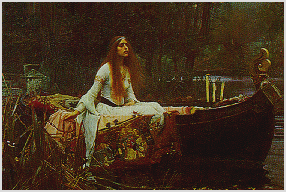

 |
The story of the Fair Maid of Astolat begins
when Arthur departs with his knights for a joust
that was to be held fifteen days after Our Lady's
Day of the Assumption.Originally, Lancelot was
not going, but at Guinevere's urging, he
departed to join King Arthur at the court of
Astolat. When he arrived there, he did not meet
with Arthur. Instead he went to the castle of
Astolat. Lancelot was well received by Sir
Bernard of Astolat who informed him that his two
sons were going to take part in the joust as well.
Sir Astolat also had a daughter, Elaine or The
Fair Maid of Astolat. She fell hopelessly in love
with Lancelot. She asked Lancelot if he could
wear a token of hers at the joust. However,
being faithful to Queen Guinevere, Lancelot
responded that if he was to wear a token, he
must joust in disguise. At the joust, Sir Lancelot
was victorious and he slew many knights. But
Lancelot left the joust before he could have been
declared victor since he was wounded.
During this time, Sir Gawain arrived at the castle
of Sir Astolat and was asked by Elaine who the
victor was at the joust. Sir Gawain responded
that the knight who won was unknown, but that
this unknown knight bore a white shield. The
lady then responded that the knight who won was
her true love.
|